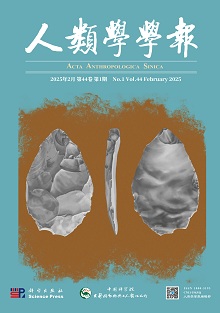The fossil materials studied in this paper, dominated by well-preserved isolated cheek teeth, were unearthed from a horizonal limestone cave named the Meiziwan Cave (29°25′22″N, 107°30′42″E, elevation 589 m asl) in Baima Town of Wulong District, Chongqing Municipality, China. Three premolars (right P4, right p3 and left p4) and six molars (two left M3s, two left m1, left m2 and right m3) were interpreted as Gigantopithecus blacki. Measurements and comparison indicate that giant ape specimens from the Meiziwan Cave are characterized by small sizes and high proportion of dental caries and with adult and old adult to be the majority, representing the primitive form of G. blacki. The deposits in the cave are mainly calcareous clay mixed with karst breccias, bearing abundant mammalian tooth fossils. The faunal association, consisting of at least six orders, fourteen families, seventeen genera, and eighteen species, coincides with those found in the Longgopo site in Wushan County, Chongqing Municipality, the Gigantopithecus cave in Liucheng County and the Baikong Cave in Chongzuo City and the Chuifeng Cave in Bubing basin, Guangxi Zhuang Autonomous Region (Guangxi ZAR) as well as the Pa’eryan Cave in Bijie City, Guizhou Province in light of the special components of the initial stage of the Early Pleistocene, for example, small-sized G. blacki, Hystrix magna, Sinomastodon yangziensis, Stegodon huananensis, Ailuropoda microta, Ursus thibetanus primitinus, Equus cf. yunnanensis, Hesperotherium sinense, Tapirus sanyuanensis, Sus xiaozhu, S. peii and Cervavitus ultimus. G. blacki become larger through time from the Early Pleistocene to the Middle Pleistocene due to the comparison of tooth measurements. In addition to G. blacki, increase of body size can be found in giant panda, tapir and black bear. Considering occurred in the Mid-Pleistocene climate transition, the tendency can be thought to be bound up with prominent climate transition and ecosystem changes, corresponding to the hypothesis of the Bergman’s Rule that endothermy animals grow larger as the climate cools.
The Meiziwan Cave is one more G. blacki locality in Chongqing, situated within the area between the Longgupo site in Wushan, Chongqing and the Pa’eryan Cave in Bijie, Guizhou. The presence of G. blacki in the Meiziwan Cave enriches the localities found near the upper and middle reaches of the Yangtze River and broadens the biogeographic distribution ranges, highlighting the significance of the evolution, extinction, paleogeographic distributions, and paleoecosystem of the Gigantopithecus fauna. Fortunately, given the abundance of karst pits, fissures and caves in the area from 30° to 18° latitudes in southern China, further investigations, excavations and research will potentially contribute to figuring it out.









